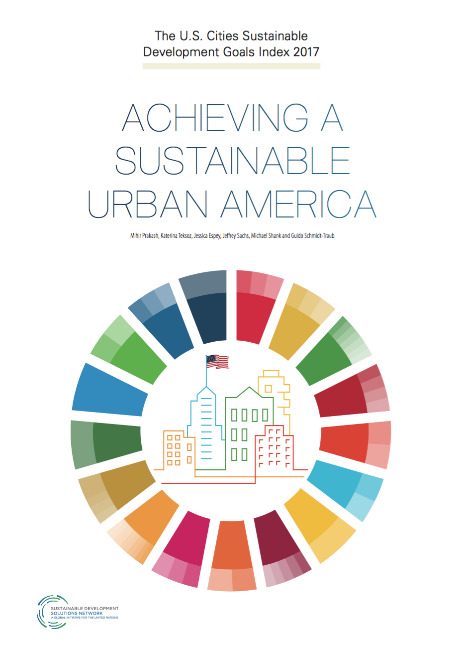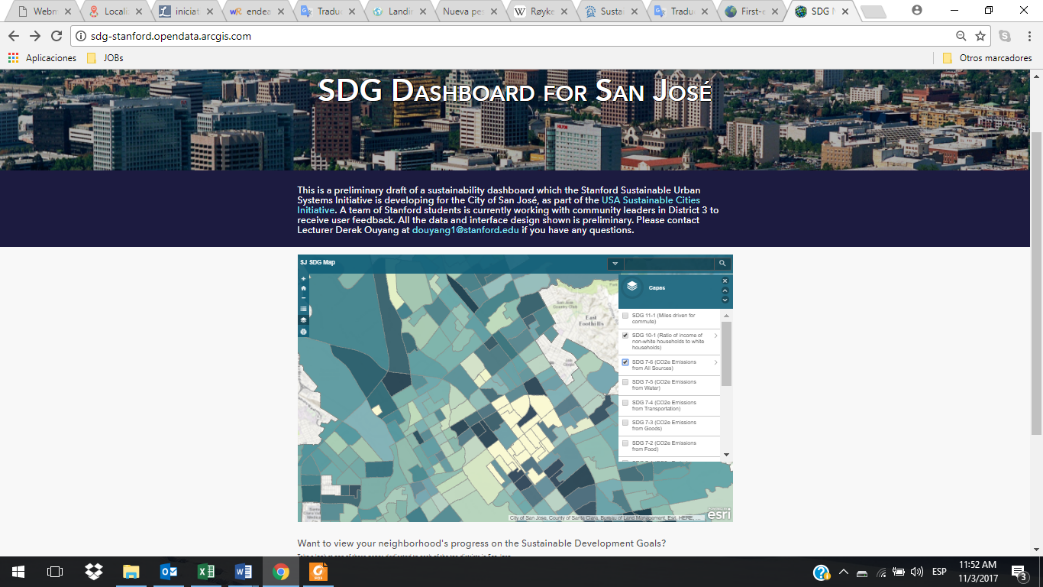
The U.S. Cities SDG Index, developed by the United Nations Sustainable Development Solutions Network (SDSN), serves as an advocacy tool that, through media pick-up and city-level dissemination, is intended to motivate the U.S. federal government to examine and track the status of sustainable development across its cities and Metropolitan Statistical Areas. The Index ranks 100 of the most populous U.S. Metropolitan Statistical Areas (MSA), as the geographic entities defined by federal government, and it takes into account indicators related to 16 out of 17 sustainable development goals (with the exception of Goal 14) that quantify information on health, economic stability, social justice and equalityThe methodology of the index follows four steps:[1]
The report places the city of San Jose (California) to the top spot of this year’s ranking, having achieved about 61 percent of the SDGs and Provo-Orem (Utah) secures the second place, with an index score of 58.05 percent. It is followed by Seattle-Tacoma-Bellevue (Washington) and San Francisco-Oakland-Hayward (also in California). According to this index, the worst-performing urban areas were Baton Rouge (Louisiana), Cleveland-Elyria (Ohio) and Detroit (Michigan).
SDG achievement strategies in three pilot US cities: San Jose (California), New York (New York) and Baltimore (Maryland).
Top ranked San Jose is also one of the three pilot cities, together with Baltimore and New York City, where the USA Sustainable Cities Initiative (USA-SCI) is being implemented.
The initiative strives to help cities across the United States implementing the Sustainable Development Goals. Led by SDSN, it brings together academic institutions, like universities, and key stakeholders which, through a collaborative effort, support municipal leaders in identifying appropriate indicators and in designing robust monitoring frameworks for the SDGs as a way of developing SDG-based city-level development strategies that could serve as a model for cities worldwide.
t also explores ways to share data across departments — and with the public — and to cross check it with non-governmental data. The ultimate goal is to provide a blueprint for subnational monitoring of the Global Goals.
A closer look to the initiative
San José, California
The city is an example of how the SDGs localization goes beyond the establishment of strategies and plans (see for instance its Environmental Sustainability Plan and Smart City Vision) and it requires the direct engagement of everyone across neighborhood communities. Based on the understanding that individuals need to understand and have the power to have a personal impact on the SDGs implementation process, the city wants to empower its citizens. For instance, through the SDGs dashboard created by the Stanford University via interim solution, a series of geospatial and census-based datasets are used to better understand the current status of SDG implementation across its territory. This tool is part of the initiative “Data tools for the California Bay area: actionable intelligence for cities to support SDGs achievement” that uses available data at various levels of disaggregation, from the block level up to the metropolitan region in order to develop an actionable intelligence system at the city level to achieve the SDGs. (Click here for San Jose’s report.)
New York, New York
New York has elaborated the OneNYC; plan for a strong and just city. Developed with locally-focused goals and initiatives that join economic and environmental sustainability with social inclusion, it aims to align the city plan with the SDGs. In this context, already in 2015, the city launched the initiative “Global Vision / Urban Action. A city with global goals”. Now, in partnership with Columbia University and SDSN, New York City officials have also started to examine further how to complement the initiatives included in OneNYC with additional activities that can contribute to the implementation and monitoring of the sustainable development agenda.
Baltimore, Maryland
In Baltimore (check here the city´s report) in order to develop citywide targets and strategies to achieve the SDGs, the Baltimore Neighborhood Indicators Alliance and the College of Public Affairs at the University of Baltimore conducted a range of consultative meetings that led to the adoption of a “listening-to-the-listening” approach to ensure inclusive engagement and non-duplication of effort and resources.
To conclude, through these three examples, the U.S Cities SDG index highlight that the SDGs are offered as a set of integrated objectives that can facilitate the definition of a more sustainable vision of urban development, one that provides equal opportunities to all inhabitants, promotes healthy living environments with access to green spaces, and is resilient in the face of everyday disasters and climate risk.


For more information about the localization of the SDGs through the USA-SCI: http://unsdsn.org/what-we-do/solution-initiatives/usa-sustainable-cities-initiative-usa-sci
[1] For a detailed list of indicators, definitions, calculation methodology and their source, please see Annex C: Sources and Definitions of the index document available in: http://www.localizingthesdgs.org/library/view/372

Comments